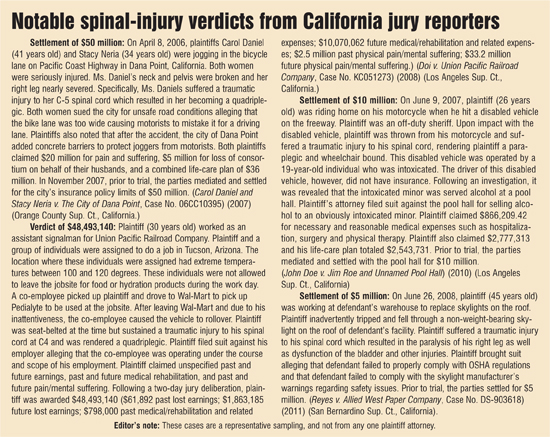Damages: Spinal cord and peripheral nerve injuries
A guide to the high-risk business of trying spinal-injury cases
Absent death itself, an injury to the spinal cord and peripheral nerve is one of the most serious injuries an individual can endure. The spinal cord and the brain together make up the central nervous system. The central nervous system controls and coordinates all motor control movements throughout the human body. The spinal cord is also responsible for informing the brain of sensory functions that an individual physically feels; for example, whether a cup of coffee is too hot or that the prick of a splinter was painful. It is worth noting that although the spinal cord and peripheral nerves assist the brain in controlling both motor functions and sensory functions, such functions are not mutually exclusive.
The spinal cord
The brain and the spinal cord together comprise the central component of the nervous system. The spinal cord is a long thin tubular tissue which extends from the brain of a human body and varies in length. The spinal cord can also be viewed as being split into spinal nerve segments ranging from the vertebrae’s C1 to L5. Overall, there are 33 spinal-cord nerve segments in the human spinal cord. The spinal cord’s major functions are to transmit signals and sensory information between the brain and the body. Each spinal nerve serves a specific function in the sensory and motor functions of the human body. For example, the C5 and C6 are responsible for movement and sensory of the shoulder and arm, while the L2, L3, and L4 are responsible for movement and sensory of the leg, while C1-C6 is responsible for movement and sensory of the neck.
The peripheral nerves
In addition to the brain and spinal cord, there are also a number of nerves which assist in controlling and coordinating all movements of the human body. One such set of nerves are the peripheral nerves. The peripheral nerves are 43 pairs of motor and sensory nerves which are outside of an individual’s brain and spinal cord. Peripheral nervous systems are just outside of the bony protection of the skull and spinal column. Branching from the spinal cord and the brain, these nerves leave the bony protection and travel throughout the body. Several of the peripheral nerves are well known, such as the sciatic nerve (a primary nerve of the leg), the ulnar nerve (forearm and hand), and the brachial plexus (a network of nerves which serve as a hub for the entire upper limbs, C5-C8, including the ulnar nerve and radial nerve). The peripheral nervous system is responsible for connecting the spinal cord and brain with the limbs in the human body. The peripheral nervous system contains two types of cells – one type of cell transmitting information regarding motor sensory and control functions and the other type of cell transmitting information regarding sensory functions.
A common analogy used to illustrate the spinal cord and peripheral nerves is to imagine a tree. Now, I’m not talking about a (bare) tree lying in the dead winter of New York City. I’m talking about a delicate yet robust tree with extensive/spanning roots that run through the trunk out to its branches, and all parts are just as vital for survival and adaptation. A tree’s water supply starts as its root moves up the trunk and extends through branches to the leaves and nutrients return along the same path but in retrograde. If there is damage to the trunk (spinal cord) of the tree, damage can be extensive and include several different areas of the tree. In comparison, damage to a branch (a peripheral nerve) is more localized in its effect.
Damages
Motor and sensory functions are often overlooked in the everyday life of most individuals. However, due to the essential role these functions play in every individual’s life, old or young, rich or poor, an injury to the spinal cord and/or peripheral nerves is a devastating event. Such an injury can cause complete or partial paralysis of the muscles below the damaged site. Moreover, such an injury can also cause complete or partial loss of sensory functions distal to the damaged site. In addition, an individual may experience day-to-day difficulties with the loss of bowel movement and bladder control.
Spinal-cord injuries occur when damage is caused to the vertebrae, ligament, or disks of the spinal column. Peripheral nerve damage can also be from trauma, cancer or infections. Severe injuries are typically created when a traumatic blow dislocates, fractures, or crushes one or more of the C1 to L5 vertebrae. Traumatic blows which cause dislocation and fractures commonly occur as a result of automobile accidents, sporting accidents, and physical (violent) altercations. In fact, according to the Mayo Clinic, automobile accidents are the leading cause of such injuries, accounting for more than 40 percent of new spinal cord injuries each year.
Notably, patients who have sustained severe spinal cord injuries include former actor Christopher Reeve and former NFL player Kevin Everett. On May 27, 1995, Mr. Reeve fell while horse-riding and sustained a cervical spine injury. On September 9, 2007, former NFL tight-end Kevin Everett of the Buffalo Bills sustained a fracture and dislocation of his cervical spine while attempting a tackle during a kickoff return.
Unfortunately, traumatic injuries to the spinal cord and peripheral nerves are currently not treatable with modern medicine and often result in long-term paralysis.
The spinal cord and peripheral nerves are essential for functions in everyday life from walking, eating, using the restroom and practically every other activity. As a result, an attorney filing suit based on spinal cord and peripheral nerve injuries should seek damages to adequately compensate plaintiffs for such an insurmountable loss. An attorney should seek damages including but not limited to the following:
• Past and future impairment of ability to enjoy life• Loss of past and future earnings (Actual wages lost, loss of pre-injury existing vocational skill, loss of capacity to earn wages, loss of profits of engaging in business)• Necessary and reasonable medical expenses (Past medical expenses and anticipated future medical expenses)• Pain and suffering for physical injuries• Pain and suffering likely to occur in the future• Mental anguish and distress (shock, humiliation, anxiety, depression, etc.)• Loss of sexual functions• Harm from prolonged inactivity (pressure sores)
(37 Am. Jur. Proof of Facts 2d 291 (2013.))
Expert witnesses/exemplars
High costs to (hopefully) prevail
Fully litigated spinal-cord cases are exceptionally expensive to prosecute through trial. In a recent vehicle rollover/ single plaintiff / paraplegic litigation that settled during voir dire, out-of-pocket costs totaled over $600,000. Plaintiff designated 15 expert witnesses. Of the $600,000 advanced, that amount included over $526,000 in expert witness/ exemplar fees. Obviously, spinal-cord injury cases cannot be taken lightly based on the high-cost outlay necessary expert witnesses required to level the playing field against the defendant/automaker, etc.
In the above-mentioned case, the plaintiff was traveling at a very high rate of speed in a 2007 Chevrolet Tahoe when he lost control; the Tahoe flipped over and the B Pillar fractured plaintiff’s neck in a roof crush resulting in paralysis.
Beyond experts, the case required purchasing two exemplars of Chevy Tahoes that were “substantially similar” to the one involved in the actual accident. $92,000 was expended to purchase two matching Chevy Tahoes and to do all the necessary exemplar/rollover testing/ videotaping analysis, etc., of same.
Of plaintiff’s 15 designated expert witnesses, the following list consists of the expertise of 13 of those experts and the monetary expenditure paid to each. Those experts were: (1) an accident reconstructionist ($71,000); (2) a Ph.D. regarding vehicle and structural crashworthiness, crash and laboratory testing and computer simulation ($81,000); (3) a Ph.D. in the area of motor-vehicle safety, crashworthiness that lead to rollovers and occupant protection systems of vehicles ($61,000); (4) a Ph.D. in biomedical engineering, addressing how the accident relates to the causation of the injuries ($28,000); (5) a clinical neuropsychologist regarding the psychological and psychiatric effects on plaintiff ($14,000); (6) automotive tires’ expert addressing warnings related to modification of original automotive equipment ($30,000); (7) expert in safety engineering and forensic analysis regarding vehicle dynamics, vehicle handling, stability, and rollover propensity ($70,000); (8) human-factors expert addressing human perception and behavioral expectations while driving ($11,000); (9) an M.D. in physical medicine and rehabilitation plans ($10,000); (10) life-care planner (described below) ($32,000); (11) vocational rehabilitationist regarding plaintiff’s disabilities and the prognosis of both future vocation and limitations to same ($13,000); (12) medical-record reviewer (to do just that) and to prepare a lengthy chronological timeline of medical efforts for plaintiff ($9,000); (13) economist to present the lost economic damages of plaintiff ($9,000).
Life-care planner
The amount of damages sought in spinal-cord and peripheral-nerve-injury cases are often substantial. Due to the large nature of damages sought, an expert witness who has professional experience as a life-care planner is crucial in spinal-cord and peripheral-nerve injury cases. Such an expert will have a key role in justifying to the jury the substantial amount of damages sought. Following an examination of the plaintiff and the plaintiff’s injury, the life-care planner will need to review the plaintiff’s medical treatment, home-health support, educational training, vocational training, rehabilitation services, personal equipment, and many other things needed for the plaintiff to properly cope with such a severe injury. After a thorough review, a life-care planner should prepare a comprehensive document which details the future needs of the plaintiff. A thorough plan of this nature is paramount to establishing plaintiff’s needs and maximizing future damages. In addition, a life-care planner will assist plaintiff in moving forward in life by having a specific plan, routine, and outlook set forth. This will allow plaintiff to be better prepared for the future regarding plaintiff’s medical treatment, education, vocation, rehabilitation, etc. In sum, a life-care planner is one of the most important expert witnesses a plaintiff’s attorney can retain in spinal cord and peripheral nerve injury cases.
Conclusion
It is clear that damages that occur arising from a traumatic injury to the spinal cord and/or peripheral nerves are substantial and life altering. An attorney representing an individual for such an injury must be sure to plead and seek the extensive range of damages available to adequately compensate for such a devastating and debilitating injury.
Victor George

Victor L. George was CAALA’s 2005 Trial Lawyer of the Year Award. He is an Emeritus Member of the CAALA Board of Governors, sits on the CAOC Board of Governors and is a Leaders’ Forum Club member of the American Association of Justice (AAJ).
Copyright ©
2026
by the author.
For reprint permission, contact the publisher: Advocate Magazine

